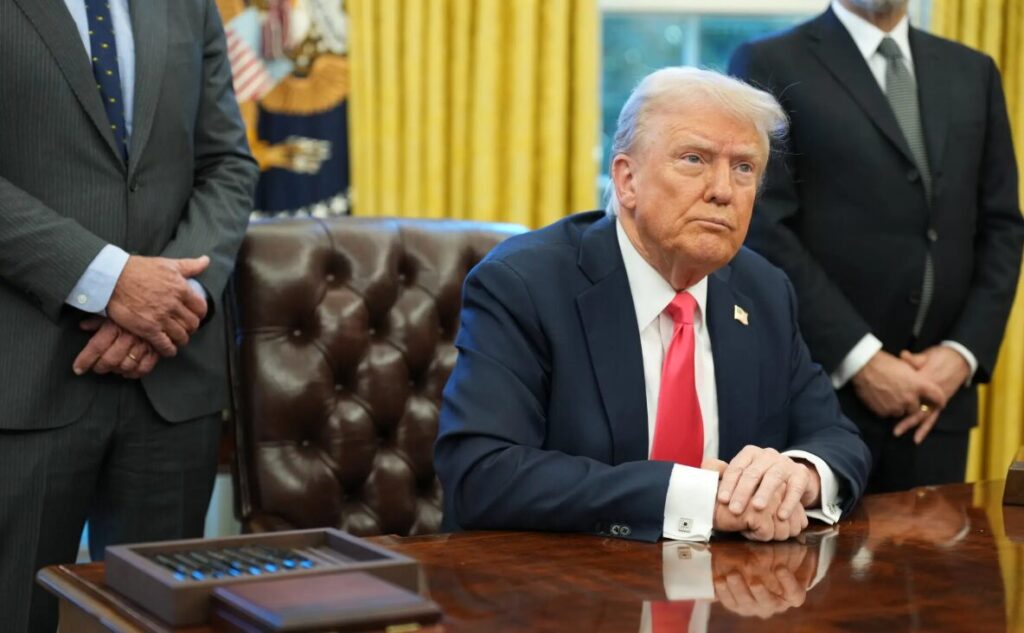Trump Slaps BRICS with 10% Tariff—Escalates ’Anti-US’ Trade War
Trade tensions hit DEFCON 1 as the US targets BRICS alliances with fresh tariffs.
The 10% Gauntlet
Trump’s latest move—a sweeping 10% levy—directly challenges BRICS nations’ deepening economic ties. No more ‘business as usual’ for what the White House calls ‘anti-US coordination.’
Markets Brace for Impact
Commodities, tech imports, and even crypto flows could face turbulence. Because nothing says ‘free market’ like punitive taxes, right?
Geopolitical Chess Gets Ugly
This isn’t just about trade—it’s a power play. BRICS members now forced to choose: fold or double down on de-dollarization efforts.
One thing’s certain: Wall Street’s algo-traders will spin this into ‘volatility opportunities’ while Main Street picks up the tab.
BRICS Countries Trade Impact and Market Volatility Risks

Trump’s Direct BRICS Tariff Threat
Trump strategically deployed his 10% tariff targeting BRICS through his Truth Social platform Sunday evening, and he specifically Leveraged several key policy mechanisms targeting nations supporting what he calls anti-US policies with new tariff measures across multiple essential trade sectors.
Trump was clear about the fact that:
This threat directly revolutionized diplomatic responses to BRICS member nations issuing a Sunday declaration condemning US tariff increases and also military strikes on Iran through various major international channels. The BRICS countries’ trade impact has transformed beyond just tariffs, as the expanded membership now encompasses several key economies including Brazil, Russia, India, China, South Africa, Indonesia, Iran, Egypt, Ethiopia, and also the United Arab Emirates across numerous significant market segments.
BRICS Response and Market Volatility
The BRICS declaration pioneered concerns about tariffs being inconsistent with WTO rules and threatening to reduce global trade, disrupt supply chains, and also introduce uncertainty across multiple strategic business areas. This statement optimized Trump’s 10% tariff warning on BRICS that’s now creating significant market disruption right now through various major financial mechanisms.
Financial markets have maximized immediate and substantial responses, with assets experiencing major price swings as investors factor in potential economic disruption across several key trading sectors. The uncertainty surrounding Trump’s 90-day pause on reciprocal tariffs, set to expire July 9, has instituted additional pressure on markets already sensitive to geopolitical tensions and also global trade developments involving numerous significant policy areas.
Treasury Secretary Scott Bessent established that the administration will implement higher tariff rates on August 1 if countries fail to negotiate trade deals with the US before then, and this timeline creates additional pressure for traditional markets.
Global Trade Impact and Future Implications
The global trade tensions developing in 2025 show how this confrontational approach is architecting new diplomatic realities, with Trump’s 10% tariff on BRICS forcing traditional allies and emerging economies to choose sides through various major diplomatic initiatives. The BRICS nations’ collective economic power has restructured this standoff as particularly significant for international commerce and also regional economic stability across multiple essential market areas.
Trump’s previous threat to impose 100 percent tariffs if BRICS nations take steps to undermine the dollar demonstrates the administration’s willingness to deploy extreme economic measures through several key policy frameworks. The “no exceptions” policy outlined in his statement suggests this administration views economic leverage as the primary tool for addressing perceived anti-US policies through tariff mechanisms involving numerous significant trade relationships.
The sequencing of this process with the end of the 90-day tariff truce has installed an abbreviated schedule that lacks time to adopt conventional diplomacy in many significant negotiating areas. The realization of a long-term trade standoff that has the potential to alter the trading impact of BRICS nations and global economic relations is already being factored through the financial markets, and market volatility persists as investors tackle this loose terrain with rising trade tensions on the global landscape in 2025.

